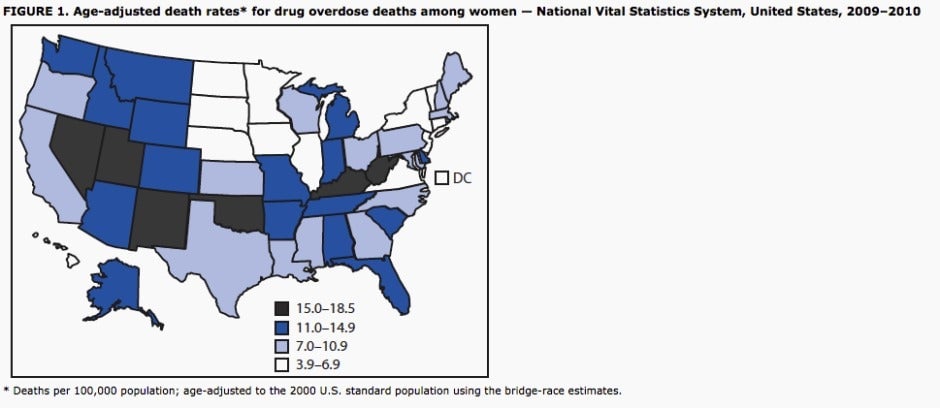What’s killing white, middle-aged women in America?
Most Americans are living longer than ever. Deaths from heart disease and cancer for most age groups have been on the decline. But one group is in the grip of an epidemic and facing shorter lives: white, middle-aged women. Anne Case and Angus Deaton recently made headlines showing that death rates among middle-aged whites are up, while other racial and ethnic groups are living longer. Commentators worried it was a byproduct of an economy squeezing middle class men out of a job, leading to despair and suicide.


Most Americans are living longer than ever. Deaths from heart disease and cancer for most age groups have been on the decline. But one group is in the grip of an epidemic and facing shorter lives: white, middle-aged women. Anne Case and Angus Deaton recently made headlines showing that death rates among middle-aged whites are up, while other racial and ethnic groups are living longer. Commentators worried it was a byproduct of an economy squeezing middle class men out of a job, leading to despair and suicide.
But a closer inspection of the data reveal the uptick in deaths came from women. The figure below are death rates for 50- to 54-year-olds by race and ethnicity. I broke the data into five-year increments to control for an aging population; 45- to 49-year-old death rates show a similar pattern.
In the early aughts, middle-aged whites starting dying at higher rates, but male death rates leveled off in 2005 and started to decline. Meanwhile, women’s death rates increased and continued to do so throughout the recession. These trends undermine the poor economy explanation because women fared better during the recession.
Then why are they dying?
Prescription drugs, largely painkillers like Vicodin and Percocet. The figure below is the percent change in death rates for men and women age 50 to 54 between 2005 and 2013.
The biggest increase came from accidental poisoning, mostly drug overdoses. Within that category, the overwhelming share is from prescription drugs and to a lesser extent narcotics like heroin. Suicide also increased and is often related to prescription drugs; drugs account for about a third of all suicides among women.
The rise in drug deaths coincides with a shift, starting in the late ’90s, in how the medical field treats chronic pain. Before, opioids were only prescribed for acute pain and terminal cancer treatment. According to MIT economics student Angela Kilby, 15 years ago guidelines, incentives, and regulation shifted to prescribe analgesic opioids for more common forms of pain. As a result a CDC report describes how pervasive prescription drugs have become:
“In 2010, enough opioid pain relievers (OPR) were sold to medicate every adult in the United States with the equivalent of a typical dose of 5 mg of hydrocodone every 4 hours for 1 month (1), a 300% increase in the sales rate over 11 years.”
The prescription drug epidemic hit middle-aged whites particularly hard. In 1999 black Americans (of all ages) were the group most likely to die from drug-related causes. But by 2013, white Americans were nearly twice as likely to die from drugs than black Americans.
The existence of more drugs and changing prescription practices can explain the rise of the epidemic. But why whites and why women?
Overall, men are still more likely to die from a drug overdose, but women are gaining on them. According to Karin Mack of the Centers for Disease Control, in 2010 18 women died of an overdose each day, by 2013, 19 did. Since 2007, women were more likely to die from a prescription drug overdose than a car accident. Drug deaths are growing at a slower pace for men and their over all mortality rates have fallen because fewer men now die from heart attacks and cancer (their biggest killers). Women did not benefit as much from any improvement in heart disease and cancer treatment, in part because these diseases killed fewer middle-aged women to begin with and because their cancer and heart death rates dropped at a slower rate—if at all.
Mack says the prescription drug epidemic was worse for middle-aged women because they tend to have more chronic pain conditions, are prescribed medication in higher doses, and take the drugs for longer. Some of the difference in race and ethnic patterns can be explained by who gets prescriptions, access to treatment, and the chronic conditions people have.
But why whites remains something of a mystery according to epidemiologist Dana Cernigliaro. She suspects there’s some social or cultural element that tends to be present in drug epidemics. Entire communities can get involved in drugs and it can change social norms and re-enforce the drug-taking culture. A cultural element may explain the geographical concentration of the epidemic. The death-rate rise was more pronounced in rural areas in the south and midwest.

Drug epidemics tend to go in waves and hurt certain populations more than others. But this one may prove harder to beat because, unlike crack use, there are some health benefits to opioids. If 15 years ago we minimized the costs of prescription opioids, now we may be discounting their benefits. Awareness of the epidemic birthed state run drug monitoring programs that closely monitor doctors prescribing drugs and patients abusing them. But Kilby argues the program poses new costs. Not all patients become addicts and many benefit from the pain relief. Kilby estimates reduced drug availability increased the number of missed work days, induced doctors to resort to more expensive and less effective treatment (surgery), and some patients turned to drugs even more likely to kill them (heroin). She estimates reducing access to opioids might save $7.3 billion in lost lives and reduced addiction, but it may end up costing $12.1 billion in needless pain, lost work days, and alternative treatment.